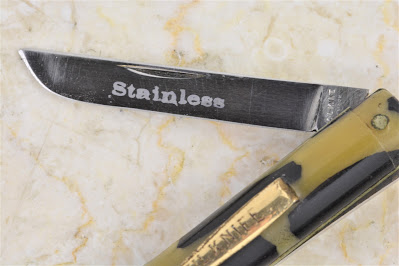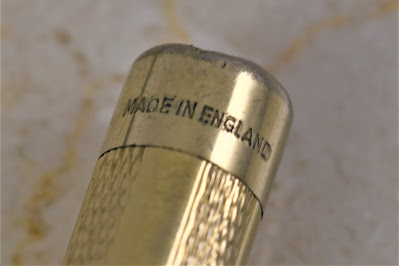This article has been included in The Leadhead's Pencil Blog Volume 7, now available here.
If you don't want the book but you enjoy the article, please consider supporting the Blog project here.
This pencil was not properly described at all in a recent online auction:
It didn’t have to be. I knew exactly what it was from that clip:
When it arrived, however, I wanted to see that tiny little mark:
Yep. That’s the hallmark for Edward Todd & Co., and it’s tough to find ones like this, made in the last few years of the company’s existence. Todd’s “Everpoint Magazine Pencils” were advertised in the February 5, 1919 issue of The Jewelers’ Circular – that’s the same issue that includes historical sketches of all the New York pen and pencilmaking firms:
These are scarce enough that I would have picked this one up even if I had five just like it – but I don’t. This one needed to be photographed alongside its gold filled brother:
“Magazine pencil” suggests that these had a space inside the pencil to store spare leads, and after this new one arrived, I took a closer look at the top end, with that little raised bump in the middle:
I fiddled around with it a little bit and learned that it twists to reveal an opening . . . and voila:
Kind of neat, and a really unique feature on an Edward Todd.
I stumbled across another later Edward Todd during a “cabin fever” escape Janet and I made to get out a little bit over the long winter of 2020. We made our way west to the Springfield antique malls flanking Interstate 70. The staff was shorthanded, of course, and after I had bothered one poor guy half a dozen times to open cases (I even bought something overpriced that I didn’t want out of guilt), he was getting a little weary of running back and forth – and he had noticed a pattern in the things that interested me.
“You know, there’s a guy on the back wall with a lot of pens and pencils,” he said. “Why don’t I just take you back there now?”
He was not wrong on both counts. There were a lot of pens and pencils in that showcase, and yes, I would have been calling him back again to paw through them. Most of it was ordinary stuff in not-so-great condition, but so starved I was for any live-action hunting in the wild that I pawed through everything like a man rescued from the desert on the verge of expiring from thirst. And I did find this:
It was on a different shelf from all the other stuff, probably because it was more special than the other things on display by a blue mile - and I nearly missed it. Again, the clip announced what it was before I picked it up . . . and without hesitation, said I’d take it.
These might have been offered by Edward Todd at the same time as the firm’s Magazine Pencil, but the only reference I’ve found to them being advertised was a couple years later. It appeared in The Jewelers’ Circular on November 30, 1921:
I just knew how nice it would look alongside one I had at home:
Both are in flawless condition. Note that while the sterling silver example has the very distinctive Edward Todd clip, the other has a more rounded one - more like a Hicks.
While my gold Magazine Pencil is gold filled, my Everpoint is the real deal. I remember it was my big splurge at The Ohio Show a few years back, and it was one of the few times I knew I would have to pay gold value and was eager to do so – there’s a lot of gold in that one:
As companies like Edward Todd fizzled out, the information that’s available becomes sparse. In an earlier series here (“From Bagley to Todd,” starting in Volume 5 at page 174), I mentioned that Edward Todd, Jr.’s obituary, which ran in the Brooklyn Daily Eagle on December 24, 1937, is the only surviving obituary for the firm that bore his father’s name: “his business was discontinued in 1932,” it states (Volume 5, page 180).
I’ve mentioned Larry Liebman’s family connection to the Louis Tamis family here before, and Larry reports that LT & Son acquired Edward Todd & Company’s machinery and tooling. There is some truth to that, but it did not occur in 1932 and it may not have been acquired directly from Edward Todd.
The 1933-1934 New York City Directory contains information which was likely gathered near the end of 1932, and it includes a listing for Edward Todd & Company. The company had withdrawn to the 8th floor of the building at 100 6th Avenue, New York – without a ground floor presence, the firm must have been on its last legs:
I also wonder how the firm’s equipment would have made it up to the eighth floor – perhaps it had already been sold off, and the company existed in name only or marketed products manufactured by somebody else. That might explain why some Edward Todd pencils are identical to those made by W.S. Hicks.
However, if Edward Todd’s equipment was sold in 1932 or earlier, Louis Tamis & Son was not the buyer, strictly speaking. Although the firm’s account of its own history states that it was founded by Louis Tamis in 1909, that isn’t accurate. The earliest reference I found to Tamis’ involvement in the jewelry industry was on July 26, 1910, when The New York Tribune reported that space had been leased at 38 Maiden Lane to a new partnership, Schanfein & Tamis:
The firm first appears in Trow’s Copartnership Directory for 1911, identifying the partners as Louis Tamis and Bernard Schanfein:
The 1933-1934 directory still reports Louis Tamis as being associated with Schanfein & Tamis, and there is no mention yet of the establishment of Louis Tamis & Son:
The 1940 Manhattan directory reflects that at some point between 1933 and 1940, Schanfein and Tamis had parted ways. Schanfein is listed as a goldsmith at 64 West 48th Street:
Louis Tamis & Son and Louis Tamis are listed at 36 West 47th Street. There’s no residence address listed for Louis, and his son isn’t listed at all:
By the 1930s, the New York City Directory had become just too cumbersome, and more manageable, separate directories emerge for each of the five boroughs. Perhaps, Tamis and his son lived in one of those other boroughs. Maybe, however, they lived across the river in New Jersey, like Ephraim Johnson.
If that’s true, some things I’ve found might make a little more sense.


















































